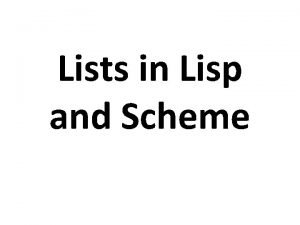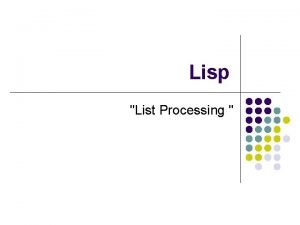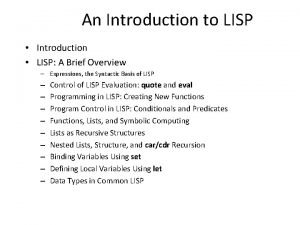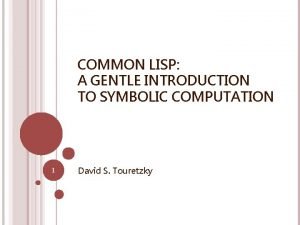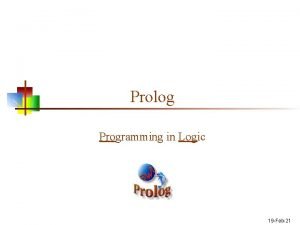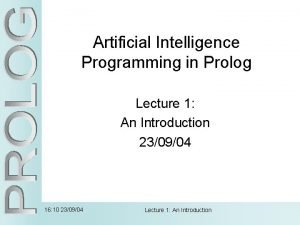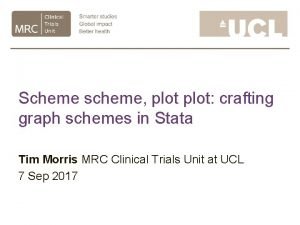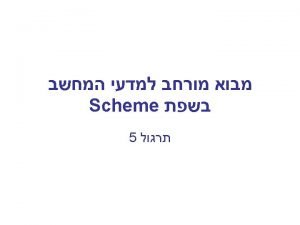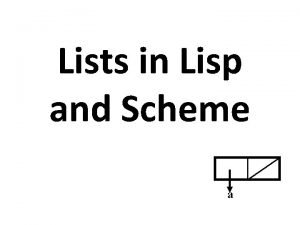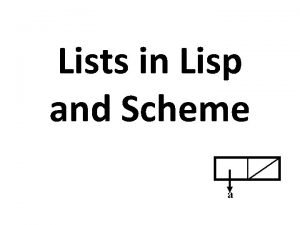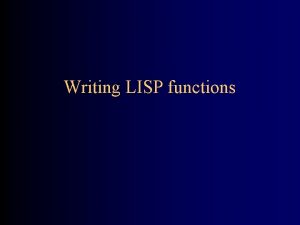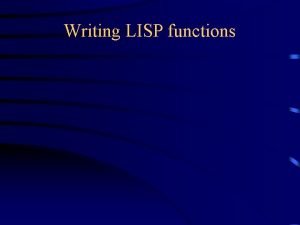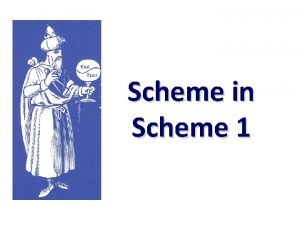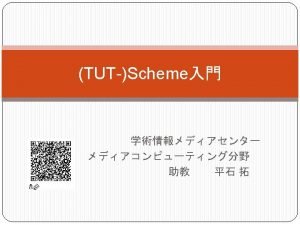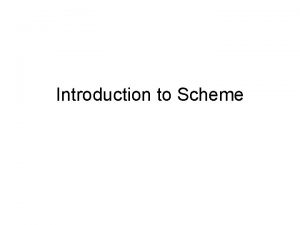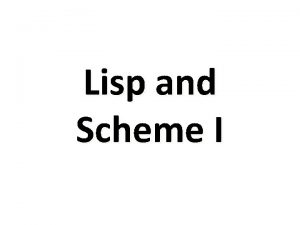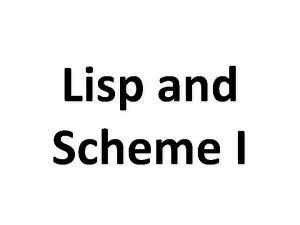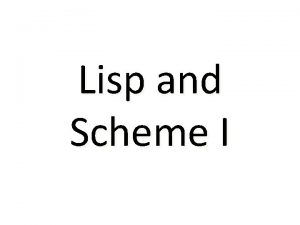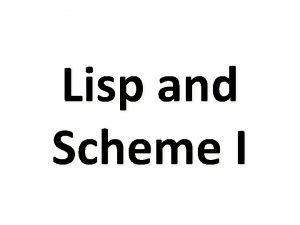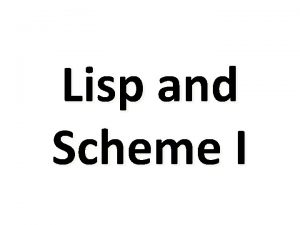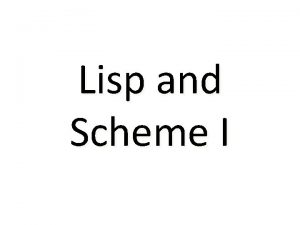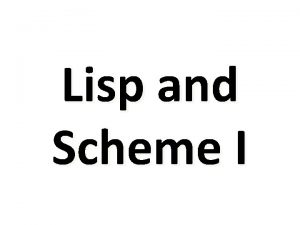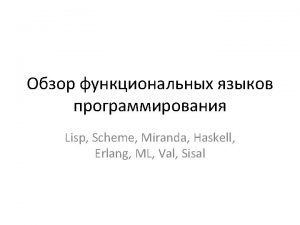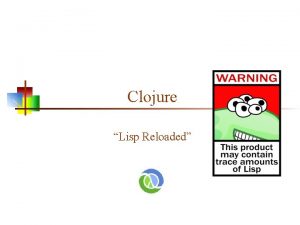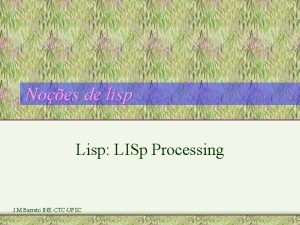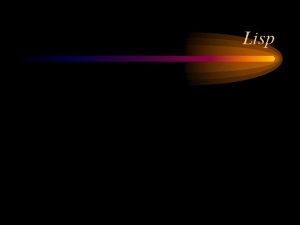Introduction to Scheme Lisp and Scheme Lisp List















- Slides: 15

Introduction to Scheme

Lisp and Scheme • Lisp: List processor language – Full recursion – Conditional expression – Extensibility – Interactive • Scheme: one of most popular dialects of Lisp. ( Another popular one: common lisp)

Dr. Scheme • Download Dr. Scheme from http: //download. plt-scheme. org/drscheme/ • Install Dr. Scheme in your computer • Set language: “advanced student”

Primitive Elements • Atoms – A string of characters beginning with a letter, digit or special character other than a single left or right parenthesis. • Lists – (atoms +/or lists) – Null • Define a atom and a list in Dr. Scheme

Evaluation • Read->evaluate->print • Imperative language – f(x) – g(x, y, z) • Lisp – (f x) – (g x y z) • In a list, first element is expected to be a function which uses remaining elements as arguments

Manipulating lists • • car: get the first element of list cdr: get the rest of list caar: get the first item of the first list in a list cadr: get the second item of a non-empty list cadar: get the second item of the first list of a list caddr: get the third item of a non-empty list cons: construct a list by two lists or a list and an atom. The second argument must be a list.

How they come? • • caar == car(car list) cadr == car(cdr list) cadar == car(cdr(car list)) caddr == car(cdr list))

A problem to solve A farmer is taking a fox, goose and bag of corn to market and must cross a river. The river has a boat that can hold the farmer and one item, so he must make multiple crossings while leaving some items unattended. If the fox gets a chance, it will eat the goose; likewise the goose will eat the corn. What’s a pair farmer to do?

Valid States • Representation: (left-bank list, right-bank list) • Initial state: ((fox goose corn boat) ()) • Tasks - define functions: • (left-bank state) : (fox goose corn boat) • (right-bank state): null • Another states: – ((fox corn) (goose boat)) – ((goose boat) (fox corn)) • Final state: (()(fox goose corn boat))

Defining functions • (define function_name (lambda (args) expressions ) ) • Function call: (function_name args)

Exercise • Current state : = ((state on left bank)(state on right bank)) • Define initial state init. State to be ((fox goose corn boat)()) • Write a function left. Bank that returns state on left bank based on current state • Write a function right. Bank that returns state on right bank based on current state

Conditional expressions • In scheme: (cond 1 val 1) (cond 2 val 2) … (condn valn) (else default-val) ) • In imperative language: if(cond 1) return val 1; else if(cond 2) return val 2; …. else if(condn) return valn; else return default-val;

Useful build-in functions • (eq? val 1 val 2) -- compare two values – Return true if the two values are the same • (> val 1 val 2) -- compare numbers for greater-than • (< val 1 val 2) -- compare numbers for lessthan • (= val 1 val 2) -- compare numbers for equality • (null? val) – if the value is empty list

Exercise • Write a function called other. Bank that returns RIGHT if bank==LEFT returns LEFT if bank==RIGHT and otherwise returns HUH

Recursive list processing • If we want to process elements of a list L with function f – First, process first element of L : f( car L) – Next , recursively process rest of L: (cdr L) • Exercise: – Write a function is. There to test if x is on list L
 Cons in lisp
Cons in lisp Lisp list processing
Lisp list processing Common lisp sort
Common lisp sort Introduction to lisp
Introduction to lisp Common lisp a gentle introduction to symbolic computation
Common lisp a gentle introduction to symbolic computation 3 domain scheme and 5 kingdom scheme
3 domain scheme and 5 kingdom scheme Lisp and prolog
Lisp and prolog Lisp and prolog
Lisp and prolog Scheme scheme plot plot
Scheme scheme plot plot Pyramid scheme vs ponzi scheme
Pyramid scheme vs ponzi scheme Positive list scheme
Positive list scheme Common lisp append
Common lisp append Positive list scheme
Positive list scheme Lisp cond
Lisp cond Lisp cond
Lisp cond Mcapply
Mcapply
